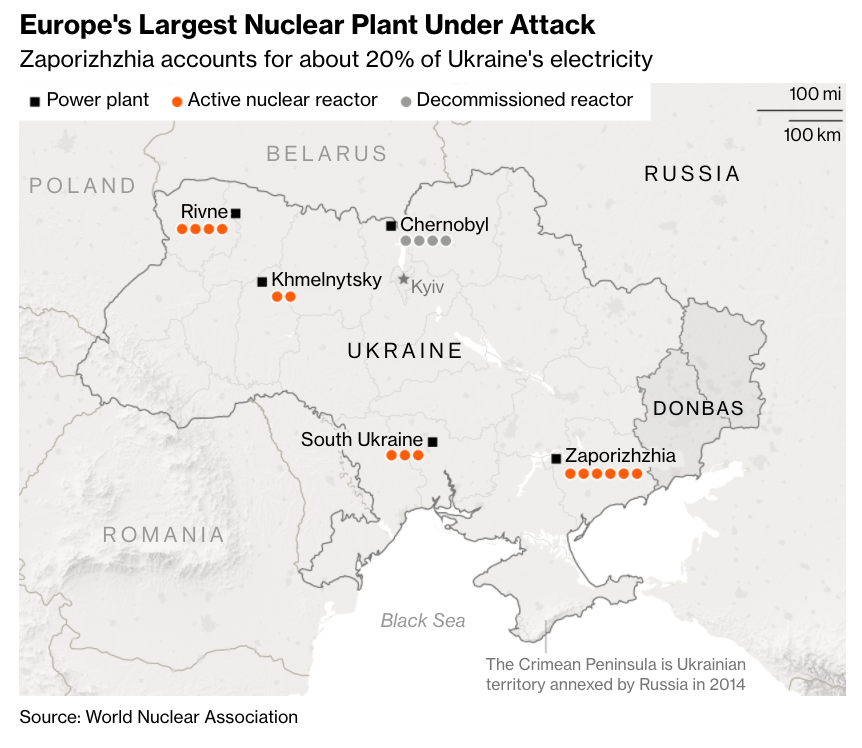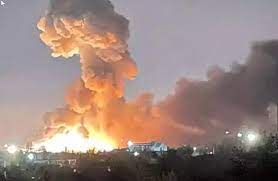Tactically, Russian invasion forces seized Ukrainian nuclear power plants with the aim to take control over the energy system of Ukraine, as well as carry out terrorist acts that would allow creating restricted areas (radioactive contamination) in case of Russian troops retreat.
Since the Chernobyl NPP was decommissioned as early as December 2000, it is unlikely that the Russians took it with the aim to сause electrical shortage.
Moreover, the Chernobyl nuclear power plant cannot be used for potential uranium enrichment, the narrative the Kremlin insisted on in the context of the risks of nuclear weapon developed by Ukraine. Thus, the only purpose of having this plant under control is to use it as a shield during attacking of Ukrainian armed forces and to carry out terrorist acts at a nuclear facility in case of retreating or curtailing the invasion operation.
Nuclear power plants, other nuclear and radiation facilities of Ukraine were designed to use nuclear energy for peaceful use. They are not intended for hostilities and should not be attacked in accordance with Article 56 of the Additional Protocol to the Geneva Conventions of 12 August 1949 on the Protection of Victims of International armed conflicts. Nuclear power plants and other nearby facilities, even military ones, should not be attacked, as this could lead to the release of dangerous forces and further heavy losses.

There is also a high probability of mining two Ukrainian NPPs captured by the Russians to strengthen Russia’s negotiating position and make pressure on both the West and the leadership of Ukraine. This scenario does not exclude the possibility of terrorist attacks (bombings) on them in case Russian units leave the territory of Ukraine.
According to the estimates of the potential consequences of the Chernobyl or Zaporizhzhia nuclear power plant accident as a result of explosion or shelling, radioactive contamination will go beyond the territory of Ukraine. In case the Confinement object in Chernobyl is damaged the territory of Ukraine, Belarus (about 44 thousand sq. km) and Russia (57 thousand km) will be contaminated.
Due to the size and number of power units (6 potential damaged units versus 1 emergencyl) the consequences of a possible accident at the Zaporizhzhia NPP could be 6 times more devastating than the 1986 Chernobyl nuclear plant accident.
Depending on the level of catastrophe severity, radiation contamination of nearby territories and the atmosphere pollution, there is a high probability of contamination of the Kakhovka reservoir waters. As a result, it will pollute the Dnieper River downstream that flows the contaminated particles to the Black Sea and make the Crimean peninsula unlivable. Such a concern is explained by short distance between the ZNPP and the Kakhovka reservoir (about 3.5 km). Spring Rainfalls could exacerbate the disaster by increasing soil and groundwater contamination. In case of northern or northeastern wind blows when the reactor is damaged, Zaporizhzhia, Kherson and Nikolaev regions, Crimea, as well as the self-proclaimed puppet DPR and LPR territories will be covered with radioactive clouds. The area of Rostov, Voronezh, Belgorod and Kursk regions (Russia) will be also contaminated. Forests and agricultural land in these areas will be forbidden to use.
Despite the fact that the fire at the Zaporizhzhia NPP on March, 4 has not yet affected the radiation background, mines placed by Russians at the station increase the risks of deliberate and accidental detonation that, as result, will damage power units and release large radiation and a lot of radioactives in the atmosphere.

Read also: Russia has launched a genocide in Ukraine





Pingback: The Kremlin's operation in Ukraine fuels Putin’s close political elite confrontation - Robert Lansing Institute